Bringing joy to customers through delightful culinary creations is a fulfilling experience for food service professionals. However, in the realm of numerous ingredients and diverse cooking times, maintaining the freshness and healthiness of food is paramount. It’s essential to handle and store food precisely to prevent the growth of illness-inducing bacteria.
Certain foods require temperature and time management to inhibit the growth of bacteria on their surfaces. Excessive time or insufficient temperatures can turn these foods into thriving environments for bacteria. This article explores further insights into Temperature Control for Safety (TCS) in food service.
What Does TCS Food Stand for?
TCS Food stands for Time/Temperature Control for Safety. The term TCS refers to foods that typically spoil more quickly than others. These foods may either naturally contain many microorganisms or have the perfect conditions for the growth of pathogens.
Introduction: What Is a TCS Food?
TCS foods are those that require specific time and temperature controls to prevent the growth of bacteria and reduce the risk of foodborne illness. TCS foods are sometimes called “potentially hazardous foods” because they provide an environment where bacteria can multiply rapidly if not handled and stored correctly.
To ensure food safety, these foods must be handled, cooked, and stored at specific temperatures. The temperature danger zone for TCS foods is typically between 41°F (5°C) and 135°F (57°C), as bacteria can multiply rapidly within this temperature range. To prevent foodborne illnesses, food establishments, and individuals must follow proper food safety practices when dealing with TCS foods.
Key Characteristics of TCS Foods
Time/Temperature Control for Safety (TCS) foods have specific characteristics that require careful handling, cooking, and storage to prevent the risk of foodborne illnesses. Some key characteristics of TCS foods include:
- Moisture Content: TCS foods often have higher moisture content, providing an environment conducive to the growth of bacteria. Examples include cooked vegetables, dairy products, and seafood.
- Protein Rich: Many TCS foods, such as meats (beef, poultry, pork), fish, and eggs, are rich in proteins. Proteins are a good source of nutrients for bacteria, making these foods more susceptible to contamination.
- Neutral pH: TCS foods often have a neutral pH, which is favorable for the growth of bacteria. Examples include meats, dairy products, and cooked grains.
- Complex Composition: TCS foods often comprise complex recipes or dishes involving multiple ingredients and preparation steps. This complexity can introduce additional points of contamination if not handled properly.
- Perishability: TCS foods are generally more perishable than other foods. They can spoil quickly if not stored at the right temperatures or if consumption delays.
- Temperature Sensitivity: TCS foods must be stored and cooked at specific temperatures to minimize the risk of bacterial growth. The temperature danger zone for TCS foods is typically between 41°F (5°C) and 135°F (57°C).
- Microbial Load: TCS foods may naturally harbor a higher initial microbial load, either from the raw ingredients or due to processing methods. This makes proper cooking and storage critical to reduce the risk of foodborne pathogens.
Examples of TCS Food
Time/Temperature Control for Safety (TCS) foods require specific handling and storage procedures to ensure food safety. Here are some examples of TCS foods:

Meat and Poultry:
- Beef
- Pork
- Lamb
- Chicken
- Turkey
Seafood:
- Fish (e.g., salmon, tilapia)
- Shellfish (e.g., shrimp, oysters, clams)
Dairy Products:
- Milk
- Cheese
- Yogurt
- Cream
Eggs and Egg Products:
- Raw eggs (including recipes using raw or undercooked eggs)
- Egg-based sauces (e.g., hollandaise)
Cooked Vegetables:
- Cooked carrots
- Mashed potatoes
- Cooked spinach
Cooked Grains:
- Rice
- Quinoa
- Pasta
Tofu and Soy Products:
- Tofu
- Tempeh
Cut Fruits and Vegetables:
- Cut melons
- Salad greens
- Sliced tomatoes
Sprouts:
- Alfalfa sprouts
- Bean sprouts
Foods with Protein-based Sauces:
- Gravies
- Stews
- Sauces containing meat or dairy
These examples highlight the diversity of TCS foods, and it’s essential to handle and store them properly to prevent the growth of harmful bacteria.
Importance of Proper Handling of TCS Food
Proper handling of TCS (Time/Temperature Control for Safety) food is crucial in ensuring the safety and quality of meals served in restaurants, cafeterias, and other food service establishments. TCS foods are particularly susceptible to bacterial growth when not handled appropriately, leading to the risk of foodborne illnesses. By following strict guidelines for storage, cooking, cooling, and reheating TCS foods, businesses can uphold their commitment to public health and prevent dangerous outbreaks.
In addition to safeguarding consumer well-being, proper handling of TCS foods contributes to a positive reputation for food service providers. With increasing awareness about food safety among customers, establishments prioritizing careful food handling practices can build trust with their patrons and differentiate themselves in a competitive market. Ultimately, consistent adherence to safe-handling protocols benefits public health and business interests by reducing the likelihood of foodborne illness incidents while enhancing customer satisfaction and loyalty.
HOW CAN TCS FOOD BE DANGEROUS?
Bacteria, when consumed, pose a severe threat to health. The growth of bacteria relies on three essential conditions: warmth, moisture, and a source of food. As these conditions align, bacteria can rapidly multiply, rendering food unsafe for consumption. Time/Temperature Control for Safety (TCS) foods create an ideal environment for bacterial growth, offering the necessary moisture and food. When coupled with the right temperature and duration, illness-causing bacteria can swiftly propagate, emphasizing the importance of proper handling and storage to ensure food safety.
Time plays a critical role in the growth of bacteria. The more time food spends in conditions favorable to bacterial growth, the greater the multiplication of bacteria on the food. Given moisture, warmth, and a food source, bacteria can double in number every 20 minutes. After sitting for four hours, most Time/Temperature Control for Safety (TCS) foods will likely harbor enough bacteria to pose a risk of making someone sick.
Three primary pathways can lead to foodborne illnesses from Time/Temperature Control for Safety (TCS) foods:
- Food isn’t cooked properly
- Food isn’t reheated or cooked to bacteria-killing temperatures
- Raw or cooked foods aren’t stored at the required temperatures.
Without proper cooking, reheating, thawing, and storage practices, foods can swiftly transform into ideal breeding grounds for bacteria that cause illnesses. Individuals consuming food teeming with bacteria may encounter food poisoning, characterized by symptoms such as vomiting, nausea, diarrhea, and cramping.
How long can TCS foods be left out?
Time/Temperature Control for Safety (TCS) foods should not be left out at room temperature for an extended period. The general guideline is known as the “2-hour rule,” which states that TCS foods should not be kept at temperatures between 41°F (5°C) and 135°F (57°C) for more than 2 hours. If the ambient temperature is above 90°F (32°C), the time limit is reduced to 1 hour.
After the specified time limit, bacteria can multiply rapidly, increasing the risk of foodborne illness. If TCS foods are left out for too long, it’s safer to discard them rather than risk potential contamination.
Related: What are Bioengineered Food Ingredients
TCS Food FAQs
We answer some common questions about TCS Food below
What is a TCS Food example?
Chicken is an example of a Time/Temperature Control for Safety (TCS) food. Chicken is considered a TCS food because it has the potential to harbor harmful bacteria that can multiply rapidly if the chicken is not handled, cooked, and stored correctly. Other examples of TCS foods include ground meat, fish, dairy products, eggs, and cooked vegetables. These foods require specific time and temperature controls to ensure food safety and prevent the risk of foodborne illnesses.
What are the symptoms of food poisoning from consuming contaminated TCS foods?
Common symptoms of food poisoning from consuming contaminated Time/Temperature Control for Safety (TCS) foods may include Nausea, Vomiting, Diarrhea, Abdominal Pain, Fever, and Headache.
Is Bread a TCS Food?
Generally, bread is not considered a Time/Temperature Control for Safety (TCS) food because it doesn’t provide a moist environment where bacteria can thrive.
Which Foods Do Not Need Temperature Control?
Beyond bread, various foods exist that do not demand meticulous temperature control. Dried beans, grains, and dry essentials such as flour and sugar fall into this category. Unopened canned goods, untouched fruits, and packaged foods can comfortably be stored at room temperature. With their lower moisture content or preserved nature, these foods generally remain stable without strict temperature regulation.
What Is the TCS Danger Zone Temperature Range?
The danger zone for TCS foods is between 41 and 135 degrees Fahrenheit.
What is Not a TCS Food?
A food that will not support the growth of disease-causing bacteria. Such foods include dry goods, dry cereals, dehydrated and unreconstituted foods, candy bars, popcorn, potato chips, canned pop, and sodas.
Conclusion: What is a TCS Food
In conclusion, understanding TCS (Time/Temperature Control for Safety) food is crucial for maintaining food safety standards in the food service industry. TCS foods are those that require time and temperature control to prevent the growth of bacteria and ensure food safety. By identifying TCS foods and following proper handling and storage procedures, businesses can protect their customers from foodborne illness. Food service professionals need to know TCS foods and the potential risks of mishandling them. Ultimately, by prioritizing safe practices around TCS foods, we can ensure a healthier and safer dining experience for everyone.
Remember, staying informed about TCS foods is a responsibility and an opportunity to promote health and well-being within our communities.
People may also like to read: What is Thai Food?




